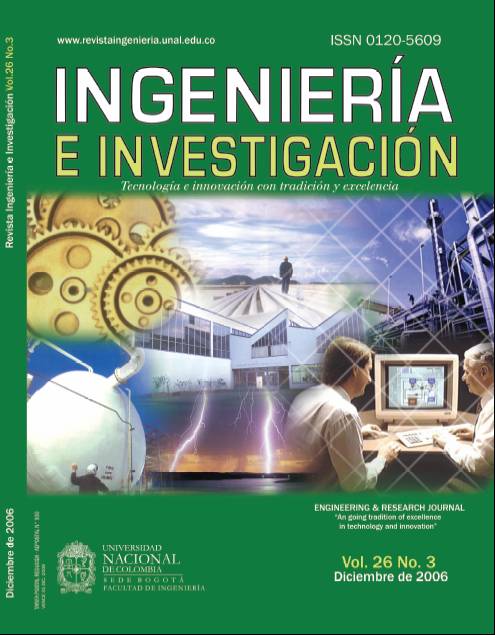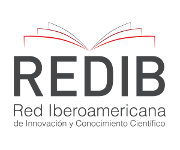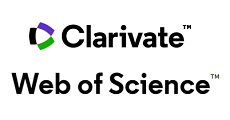Proposing and evaluating applications for products obtained during chromium chip alkaline hydrolysis produced during leather tanning
Planteamiento y evaluación de las aplicaciones de los productos obtenidos en la hidrólisis alcalina de las virutas de cromo generadas durante el procesamiento del cuero
DOI:
https://doi.org/10.15446/ing.investig.v26n3.14749Keywords:
tanning, hydrolysis, adsorption, collagen hydrolizate, chromium sulphate (en)curtición, hidrólisis, adsorción, hidrolizado de colageno, sulfato de cromo (es)
Downloads
Some applications for products obtained by chromium chip alkaline hydrolysis produced during leather tanning were evaluated in this work, considering the concept of maximising tanneries’ solid residue reuse for different industrial applications and minimising the environmental impact so produced. When Cr(OH)3 is transformed into Cr2(OH)(SO4) it can be used in tanning leather (i.e. as tanning salt). When compared to commercial salts, it was determined that it could be applied to mixtures containing this salt, replacing it by up to 40%. Chromium content reduction was evaluated for collagen hydrolyzate by pH control after alkaline hydrolysis of the chips and by applying adsorbent materials such as bentonite, alfalfa and sorghum biomass and activated charcoal, a maximum 55% Cr removal being obtained when the first two adsorbent materials were used.
Considerando el concepto de maximizar la reutilización de residuos sólidos de curtiembres en diversos usos industriales y la minimización del impacto ambiental que estos generan, se evalúan algunas aplicaciones de los subproductos obtenidos por la hidrólisis alcalina de las “virutas de cromo” generadas durante la etapa de rebajado en el procesamiento del cuero. El hidróxido de cromo obtenido transformado en sulfato de cromo monobásico puede reutilizarse en el procesamiento del cuero como sal curtiente. Al comparar su capacidad curtiente con el sulfato de cromo comercial, se determinó que puede emplearse en mezclas con esta sal, remplazándola hasta en un 40%, y con una basicidad del 33%. Para el hidrolizado de colágeno se evaluó la disminución del contenido de cromo por medio de variación del pH en el proceso de hidrólisis alcalina de las virutas, y el uso de materiales adsorbentes como bentonita, biomasa de alfalfa y sorgo, carbón activado, entre otros, obteniendo un porcentaje máximo de remoción de cromo del 55% al emplear los dos primeros adsorbentes.
References
Arraigada, R., García, R. y Cid, R., Retención de Hg (II) y Cr (VI) en Carbones Activados de Orígen Lignocelulósico., disponible en http://www.icp.csic.es/cyted/Monografias/Monogratias2001/B1-219.pdf, 2001, pp. 219-225.
Comunidad del Cuero., Disponible en: http://www.cueronet.com, 2003.
Cano, I., Pérez, J.A., Gutiérrez, M. y Gardea, J. L., Remoción y Recuperación de Cromo (III) de Soluciones Acuosas por Biomasa de Sorgo., Revista Mexicana de Ingeniería Química, Vol. 1, 2002, pp. 97-103.
Sumathi, K.M.S., Mahimairaja, S. and Naidu, R., Use of Low-Cost Biological Wastes and Vermiculite for Removal of Chromium from Tannery Effluent., Bioresuorce Technology, Vol. 96, 2005, pp. 309-316. DOI: https://doi.org/10.1016/j.biortech.2004.04.015
Pérez, M., Evaluación del Proceso de Aprovechamiento Mediante Hidrólisis Alcalina de las “Virutas de Cromo”., Subproducto del Procesamiento del Cuero, Proyecto de Grado para optar al título de Ingeniería Química, Universidad Nacional de Colombia, 2003.
Rodríguez, F y Molina, S. M., El Carbón Activado en el Procesos de Descontaminación., disponible en: http://www.icp.csic.es/cyted/Monogratias/Monogratias2001/A5-163.pdf, 2001, pp. 163-168.
Tiemann, K.J., Gardea Torresdey, J.L., Gamez, G. and Dokken, K., Interference Studies for Multimetal Binding by Medicago Sativa (Alfalfa)., Proceedings of the 1998 Conference on Hazardous Waste Research, Honolulu, Hawai, april 22-24, 1998, pp. 63-75.
How to Cite
APA
ACM
ACS
ABNT
Chicago
Harvard
IEEE
MLA
Turabian
Vancouver
Download Citation
License
Copyright (c) 2006 Andrea Díaz, Juliana Jiménez, Monica Pérez, Paulo César Narváez Rincón

This work is licensed under a Creative Commons Attribution 4.0 International License.
The authors or holders of the copyright for each article hereby confer exclusive, limited and free authorization on the Universidad Nacional de Colombia's journal Ingeniería e Investigación concerning the aforementioned article which, once it has been evaluated and approved, will be submitted for publication, in line with the following items:
1. The version which has been corrected according to the evaluators' suggestions will be remitted and it will be made clear whether the aforementioned article is an unedited document regarding which the rights to be authorized are held and total responsibility will be assumed by the authors for the content of the work being submitted to Ingeniería e Investigación, the Universidad Nacional de Colombia and third-parties;
2. The authorization conferred on the journal will come into force from the date on which it is included in the respective volume and issue of Ingeniería e Investigación in the Open Journal Systems and on the journal's main page (https://revistas.unal.edu.co/index.php/ingeinv), as well as in different databases and indices in which the publication is indexed;
3. The authors authorize the Universidad Nacional de Colombia's journal Ingeniería e Investigación to publish the document in whatever required format (printed, digital, electronic or whatsoever known or yet to be discovered form) and authorize Ingeniería e Investigación to include the work in any indices and/or search engines deemed necessary for promoting its diffusion;
4. The authors accept that such authorization is given free of charge and they, therefore, waive any right to receive remuneration from the publication, distribution, public communication and any use whatsoever referred to in the terms of this authorization.



























